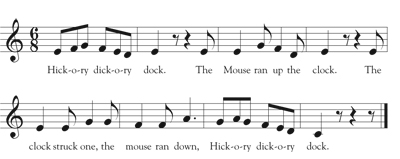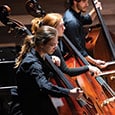
Recently there has been a growing interest in incorporating Early Music techniques and ideas into the Baroque repertoire of modern flute playing. When studying and preparing Baroque music, there are three main concepts that work together to create a Historically Informed Performance (HIP): beat hierarchy, microdynamics, and varied articulation. These concepts form the staple of a traverso flutist’s approach to phrasing and musicality.
Authors of 18th century treatises placed high emphasis on this kind of declamatory or rhetorical musical phrasing. Johann Philipp Kirnberger summarizes this sentiment eloquently in his 1776 treatise, The Art of Strict Musical Composition. “If the words were not separated from one another by the accents associated with the length and brevity of the syllables, […] the most beautiful speech [would] sound no better than the letter-by-letter reading of children.” (p.375, Yale Press)
Beat Hierarchy
Beat hierarchy is the notion that there are strong and weak beats within each bar with a strict order of importance. As a rule, beat one is the strongest in all meters. This article focuses on music written in common time. In The Notation is Not the Music, Barthold Kuijken visually represents beat hierarchy in the following way. (p. 56, Indiana University Press)

Kuijken’s diagram is a compilation of knowledge from historical treatises. The larger the number is, the greater importance that beat has in the bar. For example, look at the opening bars of Telemann’s Fantasie in B-flat Major.
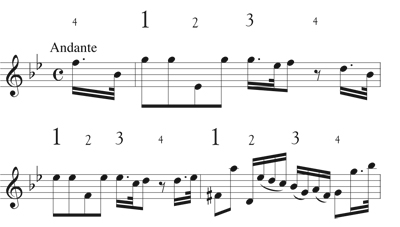
According to Kuijken’s diagram, beat one is most important. In measure 1, the first G would receive the most importance of the bar. The next most important beat in the bar is the G on beat 3. This is followed by the Eb on beat 2 and lastly the rest on beat 4. This order of importance holds true for subsequent bars unless there is a compelling reason to play otherwise.
Looking at only these four notes, it is G-G-Eb-rest in decreasing importance. All other notes within the bar are played with less importance. This includes the pickups to each bar as they fall on the second half of the weakest beat of the bar (beat 4+).
Microdynamics
In Baroque manuscripts and facsimiles, there are few if any dynamic markings. This leaves room for different interpretations. For example, one modern version is to add terraced dynamics and 4-bar hairpin dynamics. These are examples of macro-dynamics, or large scale dynamics. In HIP, microdynamics form the basis of dynamic vocabulary. These are small-scale dynamics that affect a single note or a small group of notes. They were an unwritten convention of the period and are the dynamic representation of beat hierarchy. In common time, the hierarchical microdynamics basic pattern looks like this.
f mp mf p
In addition to the basic hierarchical pattern, two more examples of microdynamics are messa di voce and diminuendo over a slur. Messa di voce is an Italian vocal technique of swelling in dynamics and intensity over a long note.
Looking at the same excerpt from Telemann’s Fantasie in B-flat major, see how microdynamics are used in conjunction with beat strength. Notice that the slur means diminuendo.
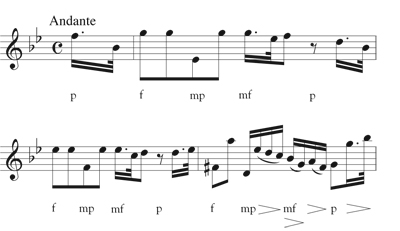
Notes that fall on strong beats are played more loudly, and notes that fall on weak beats are played more softly. As is the case with beat hierarchy, notes that do not fall on beats are of lesser importance and therefore played more softly. The use of microdynamics does not completely replace macrodynamics, but works as a hierarchal undercurrent to the overall shape of each phrase or section.
To get an idea of how microdynamics can be understood, take a look at Section 41 in Of the Manner of Playing the Adagio in Quantz’s On Playing the Flute. Quantz wrote meticulously detailed instructions for the application of microdynamics in the Adagio, which is printed without dynamic markings. Quantz’s copious dynamics suggestions are listed in sections 40-43. Try copying the Adagio in Tables XVII-XIX and writing out each of his dynamic suggestions in the score. Then play your elaborately notated version. When playing this version of the Adagio, keep in mind that Quantz advises against taking his instructions to an extreme degree. By this, he means to play the dynamic shades subtly without exaggeration. Quantz says that this way of playing was in good taste at the time. It is remarkable how different it is from how musicians play today.
Varied Articulation
Modern flutists spend many hours perfecting different kinds of articulation. This includes accented notes, staccato notes, double tonguing, low register tonguing, pianissimo high register attacks, tongueless or breath attacks, and more. Baroque flutists had a different set of varied articulations that they mastered and learned to use as their palette. These included ti, di, tiri, did’ll, du, ru, and more.
In Jacques Hotteterre’s Baroque treatise, Principles of Playing the Flute, he wrote that there are two basic types of beginnings of notes. He called them tu and ru and described their use with examples. In On Playing the Flute, Quantz calls the main two articulations ti and di. In section 5, he says that short notes should use ti since the tongue would rebound back to the top of the gums. This describes a tongue-stopped note, which was commonly used in the period. There is a definite beginning and end to these notes. Stopping a note with the tongue should be gentle and not violent. This practice takes patience to learn. Some examples of when to use this tongue-stopped articulation are before a repeated note, before a harmonically interesting note, and before a note on an important beat. Quantz added two more articulations. They are tiri for “dotted notes and moderately quick passage-work,” and did’ll “for very quick passage-work.” Modern double tonguing du-gu or tu-ku was not yet used. Other composers suggested more articulations, each a variation of a t or d attack and their combinations.
For an eye opening exercise, read Quantz’s chapter on articulation, and experiment on either a modern flute or a traverso. Try each of the examples at least a few times.
Looking at the Telemann example, notice how varied articulations go hand in hand with beat hierarchy and microdynamics. The bottom line shows an application of Quantz’s articulations, while the top line shows a more simplified adaption to better suit modern flute playing. The symbol | denotes stopping the preceding note with the tongue for clarity. T is a strong attack, t a little less, and d a softer attack.

This kind of precision of articulation gives the music a much more enunciated effect and leads to a more declamatory style of phrasing.
Putting It All Together
All three of these concepts work together to create well-defined declamatory expression. This clarifies the meaning of the music. A stage actor would not deliver a mumbled run-on sentence in a performance. A flutist should have the same amount of enunciation, diction, and rhetorical declamation as an actor speaking a soliloquy on stage.
Here is the opening of the Fantasie with all three of these components notated. It may seem daunting to keep track of all of this information while playing, but with practice, this kind of historically informed playing will become a second language.
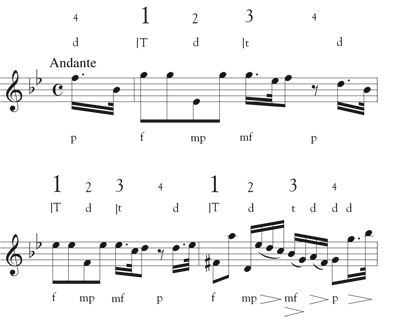
Becoming familiar with these Baroque ideas and techniques is a good starting point for flutists in their exploration of playing the traverso and their incorporation of HIP practices into modern flute playing. This kind of attention to detail leads to Baroque music that is played with wit, humor, and elegant elocution.
Seeing the Big Three in Practice
Wilbert Hazelzet, traverso professor at the Royal Conservatoire in the Hague, described the conjunction of these three concepts in his teaching at a recent masterclass in Spain. This photo of his chart at the top of the flute part to J.S. Bach’s Sonata in A Major, BWV 1032 succinctly and comprehensively depicts how these concepts work together.
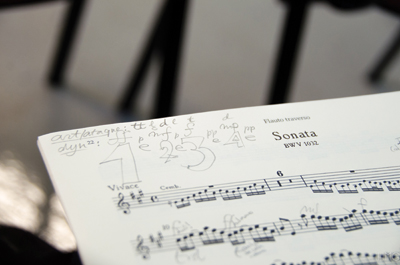
* * *
Recite a Nursery Rhyme
A fun exercise to illustrate playing with and without inflection is to read a well-known nursery rhyme (i.e. Hickory, Dickory, Dock) out loud. Set the metronome to 118 and speak the nursery rhyme out loud with one syllable per beat and no accents. Notice how the words carry little meaning when spoken in such a monotone fashion. Now, think of this rhyme in 68 meter with q. = 60 (see below). Emphasize the syllables on the down beats. Back away from the other syllables. Even without the melody, the effect is much more declamatory when the rhyme is spoken in meter while embracing beat hierarchy, microdynamics, and good articulation of consonants.
